|
1.
CENTRAL/ WEST AFRICA
West African timber trade continues, stable but slow
Trade with West Africa continues to be slow, with no
price changes of late, so there is some stability in the
market. The rains in Cameroon, Central African Republic
and Northern Congo have restricted logging and volumes
available for sawmills are being curtailed. The resulting
lower availability of sapele sawn lumber may go some
way towards inducing European buyers to arrange
shipment of their previous, existing purchases that have
been held at port, especially Douala. When this older
stock is moved into consumption, exporters hope this will
reduce the price pressures on sapele and sipo. Rains are
also expected in some areas of Gabon and this may well
reduce further activity in logging and processing, already
much restricted as companies have closed logging areas
and scaled down output from sawmills.
There are some expectations that trade with Europe will
pick up during the autumn months, but rather poor and
rainy weather in Northern Europe coupled with high
stocks of the most favored tropical hardwood species in
France and Germany may well restrict any surge in
demand to gap-filling in relatively small volume.
Sawn lumber prices reported over the previous fortnight
remain unchanged. This may be largely because there is
very little new business being concluded and producers
feel it is unlikely that lower priced offers will stimulate
sales in such dull market conditions. Many are confident
that the reductions in production and tighter supply
situation are sufficient to keep prices stable. Much will
depend on any developments in the economies in
European countries that could stimulate the building
construction industries. Meanwhile, China and India are
active buyers, providing a stabilizing measure of support
for West and Central African producers.
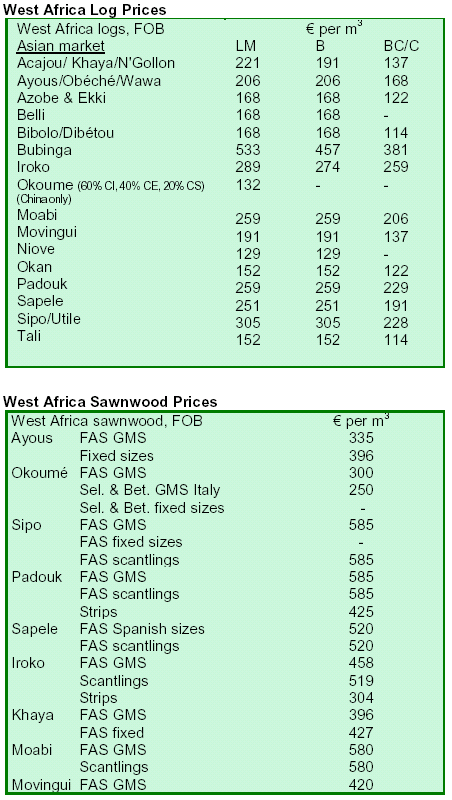
2. GHANA
Ghana climate change talks outline post-2012 policy
options
At the end of August 2008, delegates from about 100
countries met in Accra, Ghana to discuss policy options
for a post-2012 regime. The discussions, held under the
auspices of the UN Framework Convention on Climate
Change (UNFCCC), met as an Ad Hoc Working Group on
Long-term Cooperative Action (AWG-LCA). At the
opening ceremonies, the President of Ghana, J. A. Kufuor,
called for an international deal where developed countries
would provide financial assistance to alleviate the effect of
global climate change. While the one-week talks were not
designed to end in agreements on policy options, many
delegates believed negotiators were moving closer to
narrowing policy options for a post-2012 climate change
regime.
One of the key themes the meeting addressed was the role
of forests in emissions reductions. President Kufour
indicated that measures to reduce emissions from
deforestation and degradation (REDD) are key for many
African countries. However, little progress on REDD was
made at the AWG-LCA, except that results from the
recent REDD methodological meeting in Japan were
presented. Nevertheless, participants at the meeting were
able to discuss further details of accounting methods for
reducing emissions from forests and other sectoral
approaches to reduce industrial emissions. The outputs of
this meeting will be reviewed and further debated at the
upcoming 14th UNFCCC Conference of the Parties (COP)
in Poznan, Poland this December. This will ultimately lead
to final negotiations on a post-2012 climate change regime
at COP-15 in Copenhagen in 2009.
Ghana and EU sign landmark deal on illegal timber
On 3 September 2008, the European Union (EU) and
Ghana signed a Voluntary Partnership Agreement (VPA)
that is designed to stop illegally felled timber from Ghana
from entering the EU market. Agence France Presse noted
that the Agreement was regarded as a landmark deal to
fight illegal timber exports from Ghana by ensuring that
all timber exported from the country is certified as legal.
Current statistics indicate that about 60% of logging across
Ghana in recent years has been classified as illegal,
according to the World Bank.
Under the Agreement, the Government of Ghana will
impose stricter controls on logging from trees felled in
remote forests to timber loaded onto cargo ships. The EU,
which consumes more than 50% of Ghana¡¯s timber
exports (more than USD400 million a year), will ban entry
to shipments of Ghana timber that are not verified, audited
and licensed. Timber ranks fourth after gold, tourism and
cocoa in Ghana¡¯s export earnings. By signing the
Agreement, Ghana hopes to gain an edge in the EU
market.
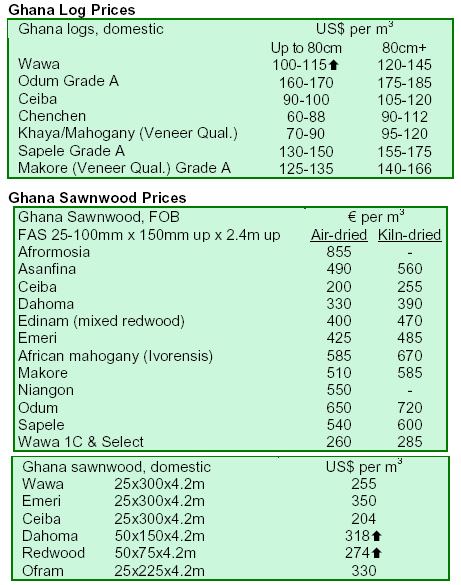
3.
MALAYSIA
Malaysian delegation to defend oil palm activities
The Star reported that Plantation Industries and
Commodities Minister, Mr. Peter Chin Fah Kui, and
Sarawak Timber Industry Development Corporation
(STIDC) General Manager, Mr. Len Talif Salleh, will be
leading a delegation in Europe to defend the activities and
operations of Sarawak¡¯s timber and oil palm industry.
They will be meeting non-governmental organizations
(NGOs) in Brussels, the Hague and London that have
claimed large tracts of forest in Sarawak have been cut
down to make way for oil palm plantations. The
Malaysian delegation is seeking to debunk the NGOs¡¯
claims in the face of mounting criticism over logging
companies¡¯ mistreatment of forest-dwellers, the Penan,
and high crime rates in the state of Sarawak.
Trade members urge end to bunker surcharge increases
According to The Daily Express, a declaration made by
members of chambers of commerce and various trade
associations in Sabah urged the government to stop
shipping cartels from raising the Emergency Bunker
Surcharge (EBS) on 15 September 2008. They also
suggested the government establish a body to control the
surcharge. Shippers have only recently increased the EBS
to RM853-RM1,706 per 20 foot and 40 foot containers,
respectively, on 15 June 2008. The cartel wanted to again
increase the EBS to RM1,253 on 20-foot containers and
RM2,506 for 40 foot containers. The revised EBS would
be applicable to all shipments loaded on or after 15
September, including those on the following shipping
lines: Chong Fui Shipping and Forwarding; Geniki Lines
Sdn Bhd; Hub Shipping Sdn Bhd; Johan Shipping;
Malaysia Shipping Corporation; MISC Berhad;
Perkapalan; Dai Zhun Sdn Bhd; and Shin Yang Shipping
Sdn Bhd. The raised rates would be applicable at all ports
served by these shipping lines and payable with ocean
freight on a prepaid or collected basis.
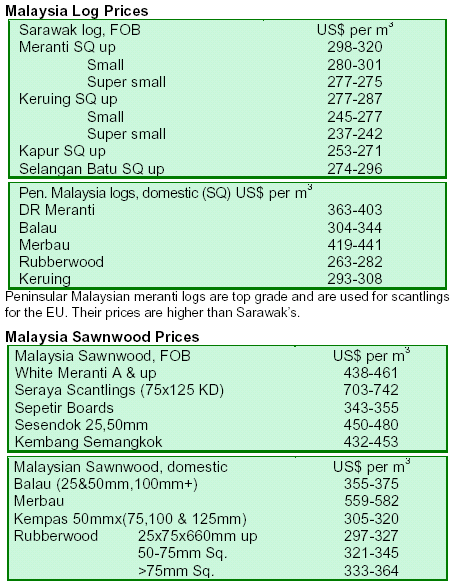
4.
INDONESIA
Indonesian timber companies to be inspected for illegally felled timber
The Jakarta Post reported on new measures for Indonesian
timber companies, which will be required to have their
inventory inspected from the start of the supply chain to
ensure it is from legal sources. The Ministry of Forestry
will appoint independent auditors and consult local
stakeholders to verify the timber chain of custody. The
auditors will conduct field checks where timber is logged.
In addition, companies utilizing timber as a raw material
will need to obtain official legal certification by the
government to verify their source materials as legal.
Companies that do not comply with the above system will
be prosecuted or have their operating licences revoked.
The new system, called the Wood Legality Verification
System (SVLK), will replace the current approach to
inspecting legal documentation for timber by the Forestry
Industry Revitalization Agency (BRIK). The Indonesian
Ecolabeling Institute¡¯s (LEI) Executive Director, Taufik
Alamin, said the new system was necessary as several
importing countries including Britain and Japan require
documentation certifying the legality of timber from the
source. An LEI spokesperson said it would help by acting
as auditors and licensing authorities under the new system.
LEI and NGOs have been actively involved in the timber
verification process since 2003, when Indonesia signed a
Memorandum of Understanding with Britain to address
illegal logging.
Demand for Indonesia¡¯s timber is predicted to reach 30
million m3 this year, with a logging quota of 9.1 million
m3 set by the forestry ministry. There are currently 324
logging permit holders in Indonesia that have the capacity
to harvest 22 million m3 of timber per year.
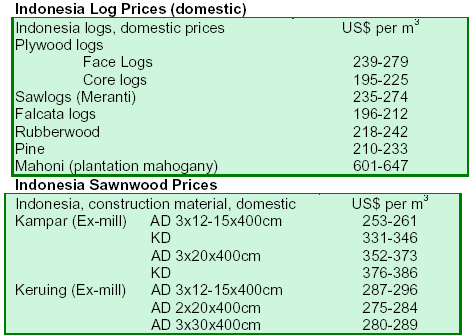
5.
MYANMAR
MTE moves away from six month average prices
New list prices for teak log sawing grades (SG) 5-8 have
been issued by the Myanmar Timber Enterprise (MTE),
replacing the six month average prices used previously.
The new prices, which are generally valid for a period of
six months, are:
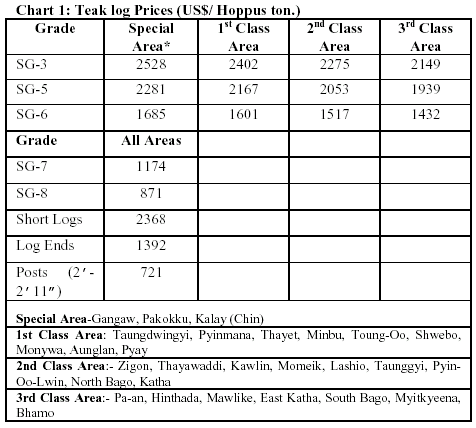
Since teak veneer grade and sawing grades 1-4 are only
sold in tender, these do not have new list prices. All prices
for teak and other hardwood logs in Euro will be updated
in the next issue of the Tropical Timber Market Report.
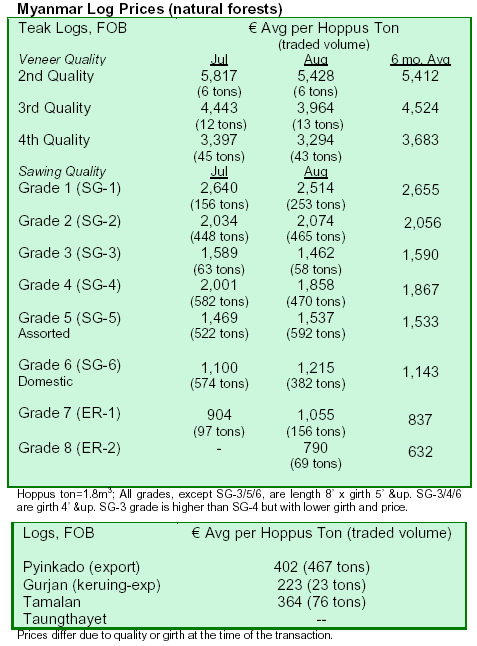
6.
BRAZIL
Norway invests funds to fight deforestation in Brazil
Valor Econômico reports that Norway will be investing
nearly USD600 million over a five year period to fund
projects in Brazil that will reduce carbon emissions. An
initial tranche of funding for upcoming activities worth
USD100 million was recently announced by the Brazilian
Minister of Environment. Norway has seen Brazil as a
model for combating deforestation, as it is known for its
high capability satellite monitoring and reporting on
tropical forest areas. Norway intends to transfer lessons
learned from its projects in Brazil to other tropical
countries.
Seven percent of Amazonia biome suitable for economic activities
A total of 7% of the entire Amazonia biome territory in
Brazil are available for urban and economic development,
said Amazon.org. The results were part of a study
requested by the federal government and conducted by the
Brazilian Corporation for Agricultural Research
(Embrapa), which considered the number of areas set aside
for environmental protection and for minority populations
over the last 15 years. According to the NGO ¡®Friends of
the Land ¨C Brazilian Amazonia¡¯, the study reinforced the
notion that the rule of law is not well-implemented in the
Amazon, since a total of 72 million hectares have been
deforested and Brazilian legal guidelines allow 42 million
hectares to be used for economic development. Embrapa
noted that the study showed an imbalance between legality
and legitimacy of land ownership, which has often
prompted land-use conflicts. Some laws and initiatives
aimed to improve environmental protection have not taken
into consideration existing partner-economic realities or
the history of the occupation of Brazil.
Amazonian timber companies look to expand exports
S¨® Not¨ªcias reported on the outputs of PROMADEIRA, an
event held for the Brazilian timber and furniture industries
in late August 2008. Timber product exports and economic
development policy were the main topics discussed. The
event provided new developments in the industries and an
opportunity to strengthen relationships between
stakeholders.
Entrepreneurs from Mato Grosso said they had high
expectations for wood production after the
PROMADEIRA event. The North Mato Grosso
Association of Timber Industry (SINDUSMAD) foresees
a new scenario for the timber industry, including the
increase of companies¡¯ sales domestically. Mato Grosso¡¯s
wood products have been highly traded in other Brazilian
states. The state¡¯s exports of veneer and plywood are sent
mainly to Europe, the US, Greece, Australia, Central
America and the Mercosur countries.
Weak dollar reduces Brazilian gains in furniture exports from Rio Grande do Sul
According to Jornal do Com¨¦rcio and S¨® Not¨ªcias, the Rio
Grande do Sul Furniture Industry Association
(MOVERGS) pointed out that sales in the first half of
2008 exceeded the first semester of the previous year by
5.1%, while the US dollar decreased 11.9% relative to the
Brazilian real in the same period. According to
MOVERGS, it would be necessary to increase sales to the
same level of USD depreciation to compensate for
exchange rate loss and production costs as well as to
ensure competitiveness.
The impact of the weakening USD dollar since 2007 has
been catastrophic when it is converted into Brazilian
currency. The total exports of Rio Grande do Sul, which
amounted to USD 166.3 million in January to July 2008,
results in BRL 279.2 million after the conversion. On the
other hand, exports last year were USD156.97 million
(BRL316.6 million) above this year¡¯s total value of
exports.
Rio Grande do Sul has kept its share of Brazilian furniture
exports around 30%. Brazil posted a 1.3% gain in furniture
exports during the first semester of 2008, with USD566.6
million against USD559.1 million recorded in 2007.
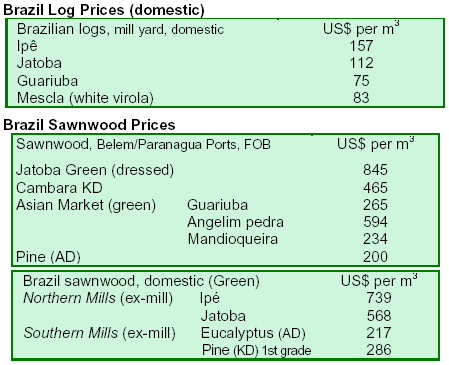
7. PERU
CITES recognizes efforts of Peru on mahogany
The International Committee of Trade in Endangered
Species of Wild Fauna and Flora (CITES) recognized
Peru¡¯s efforts over the last two years to improve the
control and management of mahogany, said Peru¡¯s
Ministry of Tourism and Foreign Commerce. During the
57th meeting of the CITES Standing Committee, recently
held this July in Geneva, Switzerland, the US and EU said
Peru made great efforts to expedite the launch of new laws
that assist in more appropriately managing mahogany.
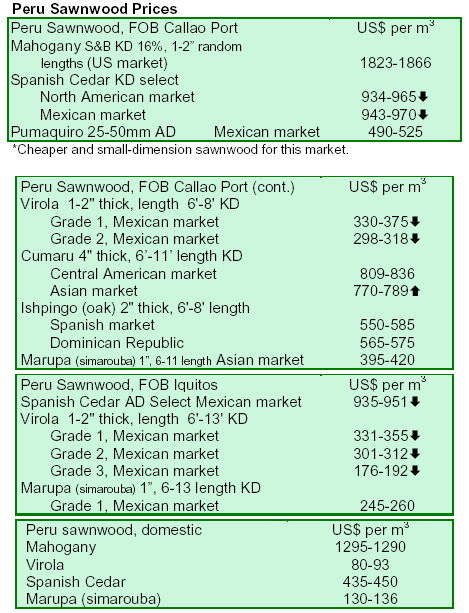
8. BOLIVIA
La Paz and Santa Cruz exports drop 17% in first half
From January to July 2008, total exports from La Paz and
Santa Cruz fell 17% when compared to the same period in
2007, decreasing from USD52.39 million to USD43.45
million. The main causes of the downward trend were the
shortage of diesel supply, depreciation of the US dollar,
and the downturn of the housing market in the US and
parts of Europe (see similar influences on quarterly results,
TTM 13:16). Individually, Santa Cruz exports fell 21%
and La Paz¡¯s fell 13% when compared to the first quarter
of 2007.
Wooden products represented 85.20% of total exports by
value (USD37 million) and non-wooden products were
equal to 14.80% (6.43 million), which largely consisted of
chestnuts without shells. By value, exports fell 22% when
compared to the same period of 2007. By volume, wooden
products fell 19% from 60,261 m3 to 48,914 m3, caused
mainly by decreasing exports of furniture, doors, chairs,
tables, moldings, plywood and wooden fiberboards. Sawn
wood was the first exported product by value (USD14.14
million), followed by doors (USD4.13 million), plates
(USD4 million), fiberboard (USD2.8 million), other
furniture (USD1.68 million), chairs (USD1.36 million and
decking (USD1 million).
The most important species was almond (USD5.96
million), followed by morado (USD5.21 million), pink
lapacho (USD3.45 million) and curupau (USD3.37
million). The US was the most important market for
Bolivia¡¯s wood products exports, valued at USD13.78
million. China is the second largest destination market
(USD4.14 million), followed by Argentina, Brazil and the
UK. A total of 44 countries purchased Bolivian products
during the first half of 2008.

9.
Mexico
Forest Expo showcases solutions to climate change,
desertification and poverty alleviation
From 4-6 September 2008, the city of Guadalajara,
Mexico, hosted Mexico¡¯s Sixth 21st Century Forest Expo.
The Expo, which was estimated to receive over 15,000
visitors, exhibited the country¡¯s most important issues on
business in the forest sector, forest products, and other
forest competitiveness issues. Business roundtables,
consisting of forestry experts, producers, technicians and
artisans, were also held and over 70 presenters exhibited
their products.
Mexico achieves Guinness World Record by planting
348,000 trees in Durango
The National Forest Agency (CONAFOR), with the
support of 300 tree planters in Durango, set a new
Guinness World Record by planting 348,000 trees in 24
hours on the 29 and 30 of August 2008. The reforested
area consisted of 179 hectares and contributed to Mexico¡¯s
goal of planting 280 million trees this year.
10. GUYANA
Guyana¡¯s value added exports show positive results
Three of Guyana¡¯s added value products - moldings,
shingles and sawnwood - were among those which showed
positive gains over the period January to August, 2008
when compared to the previous year¡¯s corresponding
period. These three product segments of the forest
processing industry have been showing increasingly
favorable results over 2008, with encouraging prospects
for the coming six months. Export volumes of moldings
continue to increase to the Latin America/Caribbean
region, which has largely consumed all moldings exported
from Guyana. The leading export destination continues to
be Barbados, consuming mostly purpleheart moldings,
while large amounts of kabukalli moldings continue to be
exported, but in relatively smaller amounts.
Export volumes of purpleheart moldings to date were
58.3% greater than corresponding period of the previous
year, while values were consistently higher, owing to
higher average prices received for this species. The
average value for purpleheart moldings to date has
increased over 2007 figures. Moreover, overall volumes of
moldings to date are 10.2% greater than that of 2007
figures.
Shingles exports also grew by 27.9% by volume and
72.3% by value when compared to the same period of
2007. Sawnwood exports rose 9.8% by volume and 18.9%
by value. Roundwood exports increased 2.5% by volume
and a notable 18.2 % by value over the same period.
Debates in forest sector shift from log to sawnwood exports
The Guyana Forest Commission has noted a changing
trend in the forest sector during the first half 2008.
Revenue earnings for Guyana¡¯s wood products, which had
previously been from the Asia/Pacific Region, were
mainly from the Latin American and Caribbean Region,
accounting for USD8.38 million and USD8.84 million
respectively in the first half of 2008. Exports also shifted
by product, with the largest revenue earner being
sawnwood instead of logs (the leading product in revenue
in 2007). The largest increase in revenue was dressed
sawnwood, which increased significantly both by volume
and value from the same period in 2007. The changing
trend comes at the heels of significant debates in the forest
sector on the importance of moving away from the export
of logs toward processing activities and exports of added
value products.
Results of ITTO project shows utility of LUS
The implementation of the ITTO project ¡®Utilization of
Lesser Used Species in Guyana¡¯ will be brought to a close
in September 2008. The main aim of the project was to
expand the species utilization base in Guyana and to
encourage the use of species with characteristics similar to
those of prime commercial species in Guyana. The ITTO
project was designed to provide concrete baseline
information on LUS, supported by scientific evidence, to
boost the utilization of these species and inform Guyana¡¯s
forest sector marketing and promotion efforts.
The final deliverable and a major concluding component
of the project was the results of laboratory tests on the
natural durability of 10 LUS: dalli (virola), wadara
(Guyana oak), kurokai (breu), futui (Guyana birch),
muneridan, iteballi (ouaruba), burada (parinari),
morabukea (Guyana cherry), black kakaralli (Guyana
maple), and tonka bean (cumaru).
The tests for natural durability were conducted by a UK
consultancy firm, which assessed the results using
European laboratory standards EN 113:1996 and EN 350
Part 1:1994. The results show that of the 10 species
tested, 3 species are very durable, 2 species are durable
and 4 species are moderately durable ¨C all measured
against the mean % mass loss with corresponding x-value
reading. The results are summarized below:
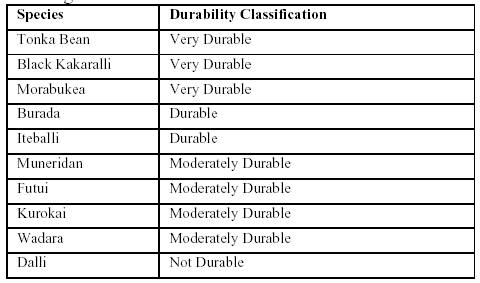
Previous laboratory tests were conducted on the resistance
of these species to abrasion and attack by Limnoria
quadripunctata Holthuis (marine borer). These results had
also shown positive results for many of the LUS species
against the benchmarked species of ekki and greenheart.
These results presented encouraging findings for the GFC,
which has indicated the results will help inform forest
producers and exporters on the utility of LUS and
contribute to ongoing work of the GFC.
President of Guyana encourages new means of
financing at UNFF CLI
The UN Forum on Forests recently concluded a countryled
initiative (UNFF CLI) in Suriname on financing
sustainable forest management (SFM), which was
organized by the Government of Suriname and convened
from 8-12 September 2008. At the meeting, the President
of Guyana, His Excellency Bharrat Jaogdeo, underlined
the importance of financing SFM and the urgent need to
look beyond the traditional means of financing. The
President of Guyana emphasized the complexity of trying
to establish values for ecosystem services for high forest
cover, low deforestation countries, pointing to the need to
adequately assess and account for the opportunity costs. In
making reference to circumstance of Guyana and
Suriname, the President noted that the current approaches
to REDD will not be very helpful to the two countries,
unless emphasis is placed in avoided deforestation.
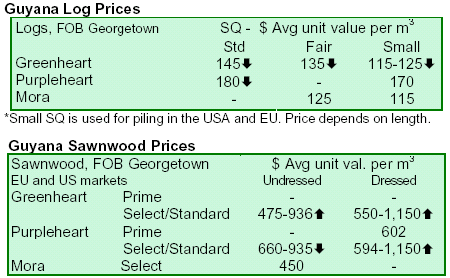
|